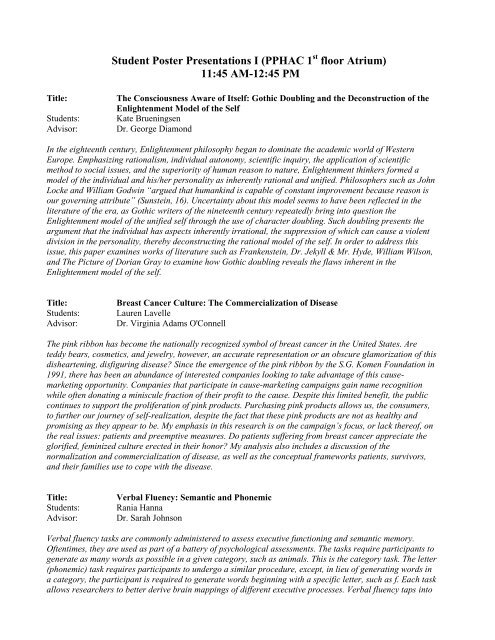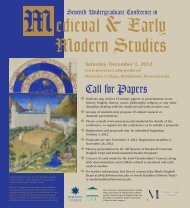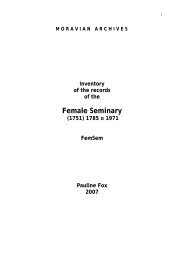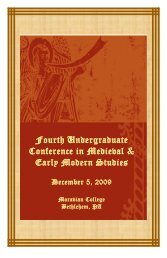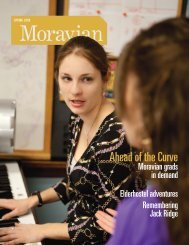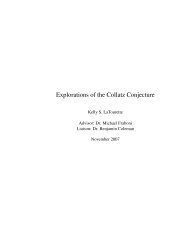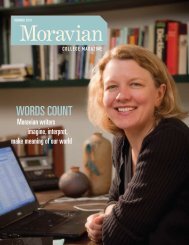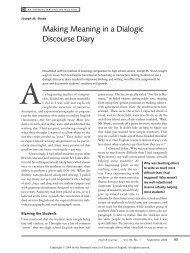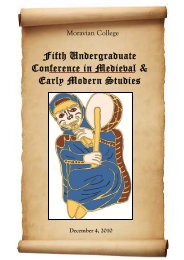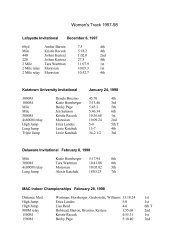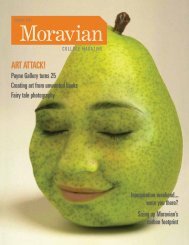Moravian College Student Scholarship and Creative Endeavors Day
Moravian College Student Scholarship and Creative Endeavors Day
Moravian College Student Scholarship and Creative Endeavors Day
Create successful ePaper yourself
Turn your PDF publications into a flip-book with our unique Google optimized e-Paper software.
<strong>Student</strong> Poster Presentations I (PPHAC 1 st floor Atrium)<br />
11:45 AM-12:45 PM<br />
Title: The Consciousness Aware of Itself: Gothic Doubling <strong>and</strong> the Deconstruction of the<br />
Enlightenment Model of the Self<br />
<strong>Student</strong>s: Kate Brueningsen<br />
Advisor: Dr. George Diamond<br />
In the eighteenth century, Enlightenment philosophy began to dominate the academic world of Western<br />
Europe. Emphasizing rationalism, individual autonomy, scientific inquiry, the application of scientific<br />
method to social issues, <strong>and</strong> the superiority of human reason to nature, Enlightenment thinkers formed a<br />
model of the individual <strong>and</strong> his/her personality as inherently rational <strong>and</strong> unified. Philosophers such as John<br />
Locke <strong>and</strong> William Godwin ―argued that humankind is capable of constant improvement because reason is<br />
our governing attribute‖ (Sunstein, 16). Uncertainty about this model seems to have been reflected in the<br />
literature of the era, as Gothic writers of the nineteenth century repeatedly bring into question the<br />
Enlightenment model of the unified self through the use of character doubling. Such doubling presents the<br />
argument that the individual has aspects inherently irrational, the suppression of which can cause a violent<br />
division in the personality, thereby deconstructing the rational model of the self. In order to address this<br />
issue, this paper examines works of literature such as Frankenstein, Dr. Jekyll & Mr. Hyde, William Wilson,<br />
<strong>and</strong> The Picture of Dorian Gray to examine how Gothic doubling reveals the flaws inherent in the<br />
Enlightenment model of the self.<br />
Title: Breast Cancer Culture: The Commercialization of Disease<br />
<strong>Student</strong>s: Lauren Lavelle<br />
Advisor: Dr. Virginia Adams O'Connell<br />
The pink ribbon has become the nationally recognized symbol of breast cancer in the United States. Are<br />
teddy bears, cosmetics, <strong>and</strong> jewelry, however, an accurate representation or an obscure glamorization of this<br />
disheartening, disfiguring disease? Since the emergence of the pink ribbon by the S.G. Komen Foundation in<br />
1991, there has been an abundance of interested companies looking to take advantage of this causemarketing<br />
opportunity. Companies that participate in cause-marketing campaigns gain name recognition<br />
while often donating a miniscule fraction of their profit to the cause. Despite this limited benefit, the public<br />
continues to support the proliferation of pink products. Purchasing pink products allows us, the consumers,<br />
to further our journey of self-realization, despite the fact that these pink products are not as healthy <strong>and</strong><br />
promising as they appear to be. My emphasis in this research is on the campaign‘s focus, or lack thereof, on<br />
the real issues: patients <strong>and</strong> preemptive measures. Do patients suffering from breast cancer appreciate the<br />
glorified, feminized culture erected in their honor? My analysis also includes a discussion of the<br />
normalization <strong>and</strong> commercialization of disease, as well as the conceptual frameworks patients, survivors,<br />
<strong>and</strong> their families use to cope with the disease.<br />
Title: Verbal Fluency: Semantic <strong>and</strong> Phonemic<br />
<strong>Student</strong>s: Rania Hanna<br />
Advisor: Dr. Sarah Johnson<br />
Verbal fluency tasks are commonly administered to assess executive functioning <strong>and</strong> semantic memory.<br />
Oftentimes, they are used as part of a battery of psychological assessments. The tasks require participants to<br />
generate as many words as possible in a given category, such as animals. This is the category task. The letter<br />
(phonemic) task requires participants to undergo a similar procedure, except, in lieu of generating words in<br />
a category, the participant is required to generate words beginning with a specific letter, such as f. Each task<br />
allows researchers to better derive brain mappings of different executive processes. Verbal fluency taps into


